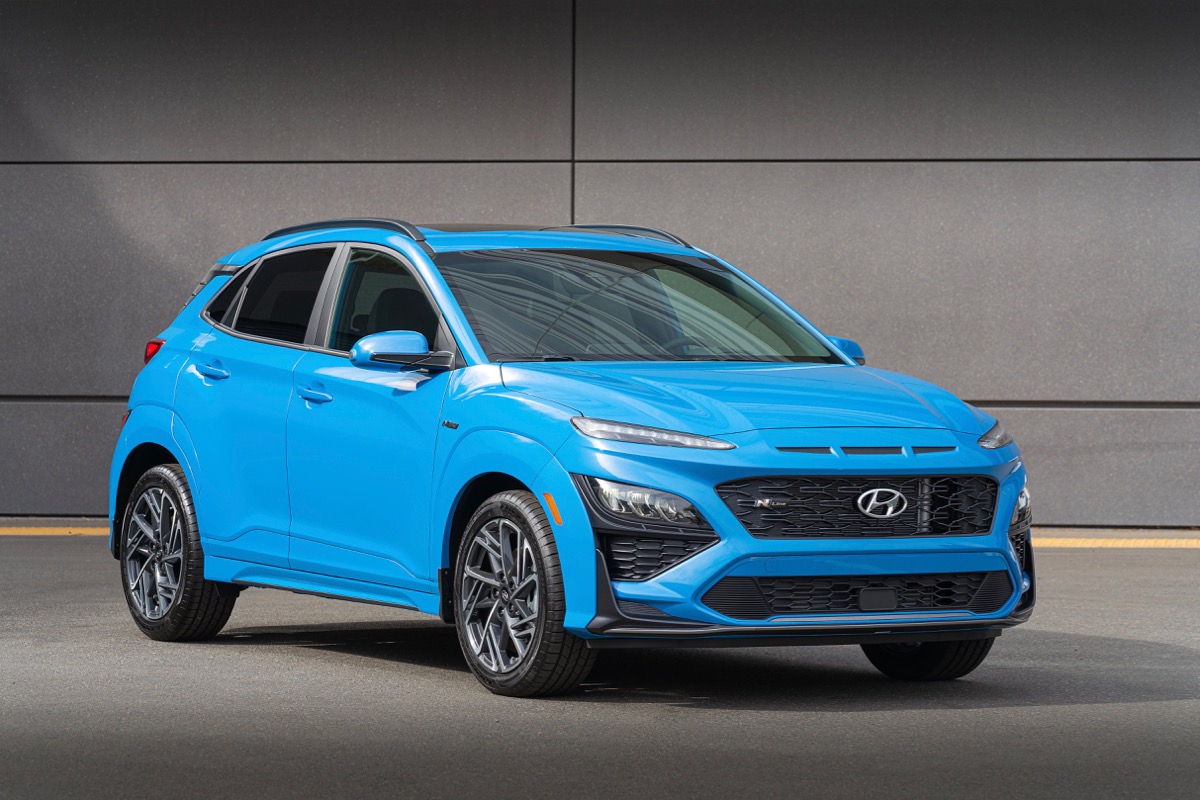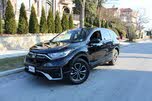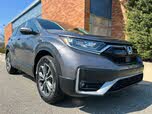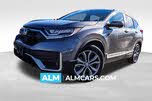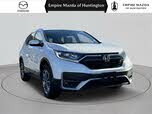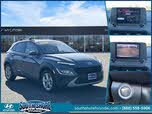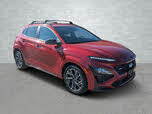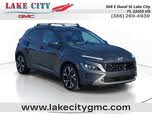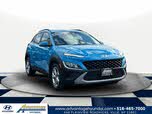2021 Honda CR-V vs 2022 Hyundai Kona
Overview | ||
MSRP | $25,350 | $21,300 |
Average price | $25,146 | $19,955 |
Listings | ||
Ratings & Reviews | ||
User reviews | ||
Expert reviews | 7.8 out of 10Read full review | 7.7 out of 10Read full review |
Pros & cons | Pros
| Pros
|
Summary | Even in a grim year, Honda is selling a staggering number of CR-Vs. The CR-V is the best-selling Honda by far. It’s also the second best-selling compact SUV, just behind the Toyota RAV4. And it's the fifth best-selling vehicle in the U.S., and if you take out all the commercial sales of full-size pickups it’s one of the two best-selling vehicles year in and year out. So it’s hard to argue against the CR-V formula. Honda’s been at this almost as long as crossovers have been a thing, launching the CR-V in 1997—a year after the RAV4 debuted. The funny thing is, aside from sales volume, there’s only one thing the CR-V particularly excels at. Aesthetics are subjective, but it would be hard to argue the CR-V is the best looking vehicle in its class. It’s not the cheapest. It’s not the best equipped, especially at the middle to lower trim levels. It’s not the fastest, nor is it the quietest, or the most fuel efficient. It’s not even the most reliable, showing up nowhere in J.D. Power's Most Reliable list. So what makes it so appealing to American consumers? Let’s see if we can figure that out. | In its fifth year on the market, the Hyundai Kona gets its first significant refresh, complete with updated exterior styling, enhanced powertrains, and upgraded convenience, connectivity, and safety features. There are also two new sporty variants—the N Line and the Kona N—giving this subcompact SUV shoppers a legitimate performance option at a budget price. |
Video | No video found | No video found |
Popular Features & Specs | ||
Engine | 1.5L 190 hp I4 | 2.0L 147 hp I4 |
Drive Train | FWD | FWD |
Seating Capacity | 5 | 5 |
Horsepower | 190 hp @ 5600 rpm | 147 hp @ 6200 rpm |
MPG City | 28 | 30 |
MPG Highway | 34 | 35 |
Engine | ||
Engine Name | 1.5L 190 hp I4 | 2.0L 147 hp I4 |
Torque | 179 lb-ft @ 2000 rpm | 132 lb-ft @ 4500 rpm |
Horsepower | 190 hp @ 5600 rpm | 147 hp @ 6200 rpm |
Drivetrain | FWD | FWD |
Fuel Economy | ||
MPG City | 28 | 30 |
MPG Highway | 34 | 35 |
Interior | ||
Seating Capacity | 5 | 5 |
Safety | ||
Front Crash Overall | 5 | 5 |
Side Crash Overall | 5 | 5 |
Dimensions & Capacity | ||
Cargo Space | 39.2 cu ft | 19.2 cu ft |
Curb Weight | 3337 lbs | 2899 lbs |
Height | 66.1 in | 61.0 in |
Length | 182.1 in | 165.6 in |
Width | 73.0 in | 70.9 in |
Wheelbase | 104.8 in | 102.4 in |
Maximum Payload | 1358 lbs | 1069 lbs |
Number of doors | 4 | 4 |
Maximum Towing Capacity | 1500 lbs | |
The 2021 Honda CR-V had a design that blended into the crowded compact crossover market. Its styling was almost indistinguishable from its competitors, with a similar "daylight opening" shape for the side windows. While the CR-V had a few unique touches like its grille and some chromed plastic features, it wasn't a vehicle that stood out based on looks alone. The color options were limited, especially for the base LX trim, which only offered black, silver, and white. The interior featured black, gray, and ivory cloth or leather, with higher trims adding wood panels and more chrome for a more upscale appearance. However, competitors like the Kia Sportage and Hyundai Tucson offered more distinctive styling, particularly in the mid-tier trims.
In contrast, the 2022 Hyundai Kona received a significant makeover, making it 1.6 inches longer than the previous model and adding revised front and rear fascias, enhanced LED lighting, and sporty new character lines. The interior saw improvements with a more horizontal layout, new ambient lighting, and a rear USB port. The addition of the sporty N Line and even sportier Kona N trims brought unique styling elements and performance features, making the Kona look more athletic. The N Line featured exclusive black seats with red stitching, a black headliner, and alloy sport pedals, while the Kona N added wide fenders, a front lip spoiler, and N sport bucket seats. Overall, the refreshed 2022 model gave the Kona a more streamlined and sophisticated look.
The 2021 Honda CR-V was not designed for high-performance driving but rather for smooth and steady acceleration and predictable cornering. All nine trims (excluding the Hybrid) came with a 190-horsepower turbocharged four-cylinder engine, achieving 0-60 mph in about 7.8 seconds. The CR-V featured a continuously variable transmission (CVT), which held engine revs constant as the vehicle gained speed. While this setup provided a smooth driving experience, it lacked the engagement found in competitors like the Kia Sportage and Hyundai Tucson, which offered conventional eight-speed automatic transmissions. The CR-V came standard with front-wheel drive (FWD), with all-wheel drive (AWD) as an extra-cost option. Its suspension setup included a MacPherson strut in the front and a multi-link suspension at the rear, providing decent handling and ride quality.
The 2022 Hyundai Kona offered a variety of engines and transmissions across its lineup. The lower SE and SEL trims featured a 2.0-liter four-cylinder engine with 147 horsepower and 132 pound-feet of torque, paired with a CVT. The N Line and Limited trims came with a turbocharged 1.6-liter four-cylinder engine, delivering 195 horsepower and 195 pound-feet of torque, paired with a seven-speed dual-clutch automatic transmission (DCT). The new Kona N trim boasted a turbocharged 2.0-liter four-cylinder engine with 276 horsepower and 289 pound-feet of torque, paired with an N eight-speed wet DCT. The Kona N also featured exclusive driving modes, launch control, and high-performance brakes and tires. Our test vehicle, a Kona N Line with the 1.6-liter turbo engine and AWD, provided ample power and a sporty driving experience, with minor turbo lag and some clunkiness in lower gears. The Kona's handling was composed and surefooted, thanks to its low ride height and AWD system.
The 2021 Honda CR-V was designed to fit five people comfortably and carry their gear. It offered 102.9 cubic feet of passenger volume and 75.8 cubic feet of total cargo volume with the rear seats folded. The cargo area could be accessed via a manual tailgate on lower trims, a power tailgate on the EX-L, and a hands-free power tailgate on the Touring trim. Roof rails were only standard on the top-of-the-line Touring trim.
The 2022 Hyundai Kona, while small, provided ample headroom and legroom for front-seat occupants. The N Line's front seats offered excellent support during spirited driving. However, rear-seat occupants faced challenges with small door openings, limited headroom due to the sloping roof, and tight legroom. Cargo space was also limited, with 19.2 cubic feet behind the rear seats and 45.8 cubic feet with the rear seats folded. Towing was not recommended for the Kona.
The 2021 Honda CR-V's base LX trim had a 5-inch color screen with Bluetooth connectivity. Other trims featured a 7-inch high-definition touchscreen with Apple CarPlay and Android Auto integration. The Special Edition and EX trims had a 180-watt audio system with six speakers, while the EX-L added two more speakers. The Touring trim had a 300-watt system with a subwoofer and satellite navigation. Charging ports were abundant, with USB ports in the front and second row, and a wireless phone charger on the Touring trim.
The 2022 Hyundai Kona added more tech for 2022. The base SE trim had an 8-inch display with Bluetooth connectivity. The SEL trim added SiriusXM satellite radio, HD Radio, and Hyundai Blue Link. The Limited and Kona N trims featured a new 10.25-inch touchscreen with navigation and traffic information. An eight-speaker Harman Kardon audio system was optional on the N Line and standard on the Limited and Kona N. Wireless Android Auto and Apple CarPlay were standard with the 8-inch screen, while the larger screen only offered wired versions. The Kona also had a 10.25-inch digital instrument cluster on higher trims and Hyundai Blue Link services.
The 2021 Honda CR-V excelled in safety, earning a five-star NHTSA overall crash test rating and an IIHS Top Safety Pick award. It featured the Honda Sensing system, which included a multi-angle rearview camera, forward collision warning, lane departure warning, automatic emergency braking, road departure mitigation, lane keeping assist, adaptive cruise control, and auto high-beam headlamps. The only feature not standard on the base LX trim was blind spot monitoring with rear cross-traffic alert.
The 2022 Hyundai Kona had a limited driver aid menu but included standard features like automatic emergency braking with pedestrian detection, lane-keeping assistance, lane-following assistance, driver attention warning, and rear occupant alert. Available technologies included adaptive cruise control, blind-spot warning, Highway Drive Assist, rear cross-traffic alert, and Safe Exit Warning. The Kona received five stars from NHTSA for overall crash protection and "Good" ratings from IIHS in all six crashworthiness tests. However, it received a "Marginal" rating for child-seat anchors, preventing it from achieving Top Safety Pick status.
CarGurus highlights

According to CarGurus experts, the overall rating for the 2021 Honda CR-V is 7.8 out of 10, while the 2022 Hyundai Kona scores 7.7 out of 10. Based on these ratings, the 2021 Honda CR-V is the better choice, offering superior safety features, more cargo space, and a higher overall rating.
Choose the 2021 Honda CR-V if:
Shop Now- You prioritize safety features and ratings.
- You need ample cargo space and passenger volume.
- You prefer a vehicle with a smooth and steady driving experience.
Choose the 2022 Hyundai Kona if:
Shop Now- You want a sporty and stylish subcompact SUV.
- You appreciate a variety of engine options and performance features.
- You value advanced technology and infotainment systems.

By: CarGurus + AI
At CarGurus, our team of experienced automotive writers remain at the heart of our content operation, conducting hands-on car tests and writing insightful guides that are backed by years of industry experience. To complement this, we are harnessing AI to make our content offering more diverse and more helpful to shoppers than ever. To achieve this, our AI systems are based exclusively on CarGurus content, ratings and data, so that what we produce is both unique to CarGurus, and uniquely helpful to car shoppers.
